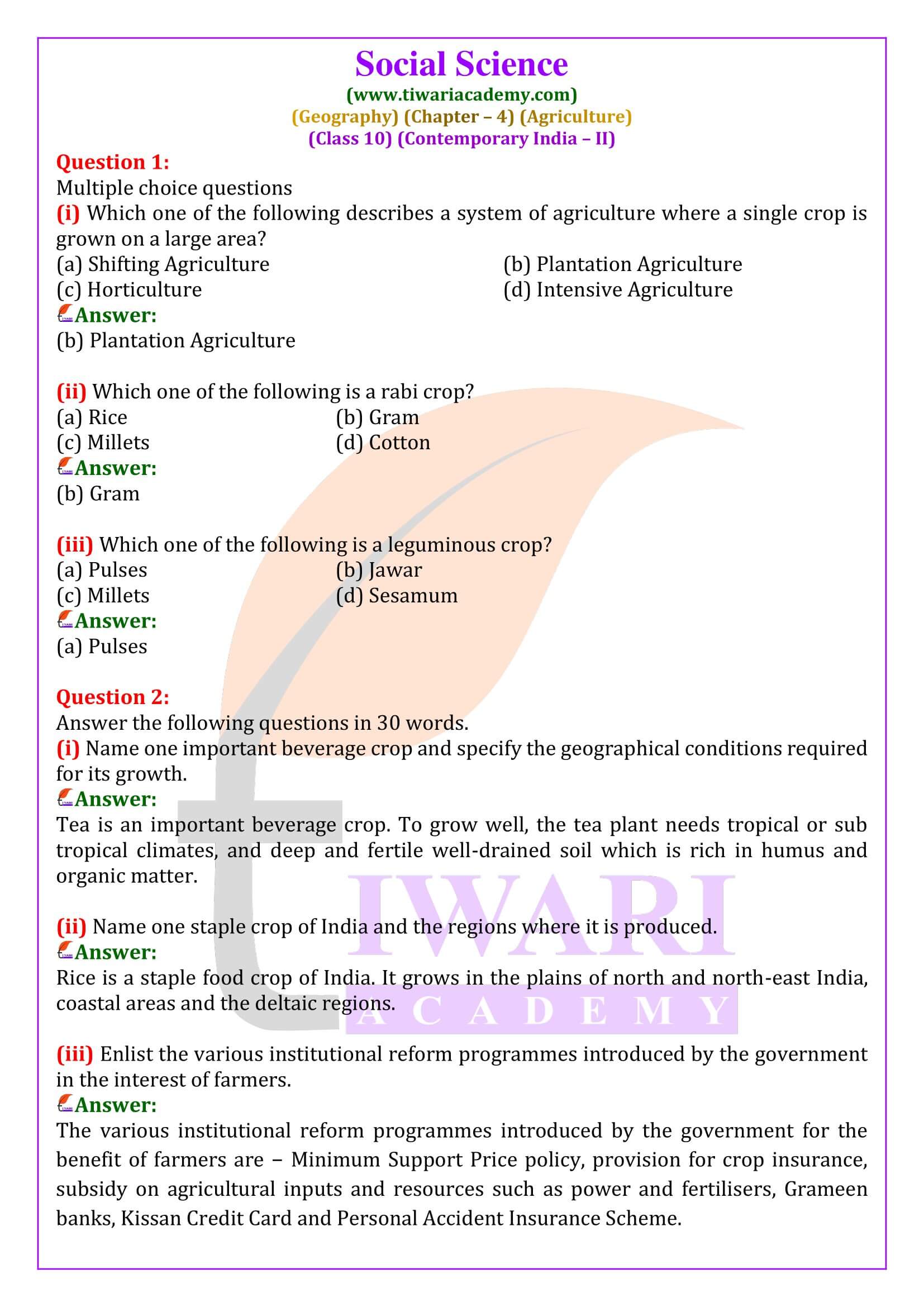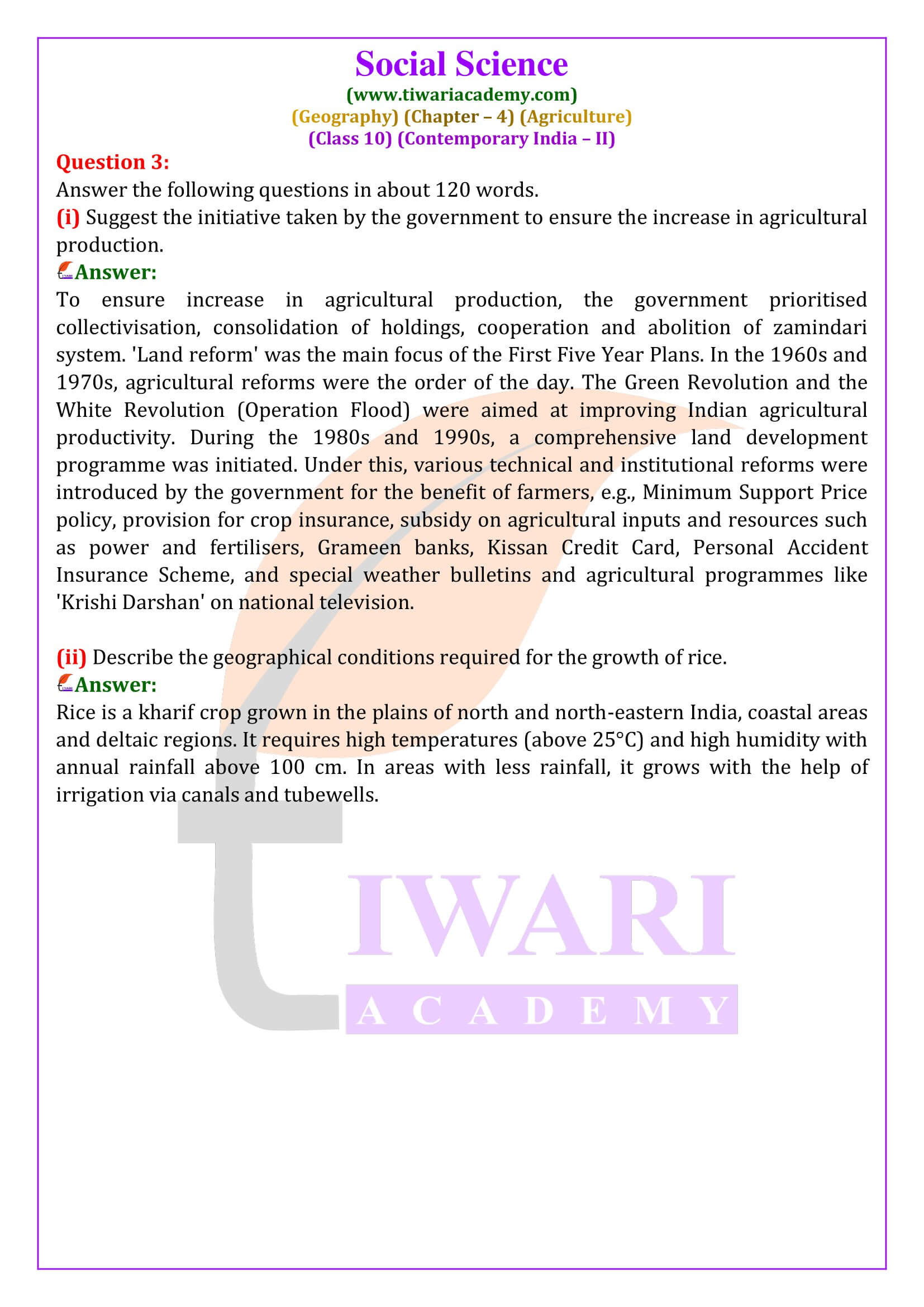NCERT Solutions for Class 10 Geography Chapter 4 Agriculture in English and Hindi Medium updated for new academic session 2025-26 based on new NCERT Books for MP, UP Board, CBSE and other boards who are following CBSE Syllabus 2025-26. For any educational doubts, please visit to Tiwari Academy Discussion Forum. This is a platform for sharing the knowledge with the others.
NCERT Solutions for Class 10 Geography Chapter 4
| Class: | 10 |
| Subject: | Social Science – Geography |
| Chapter 4: | Agriculture |
| Academic Session: | 2025-26 |
Class 10 Geography Chapter 4 Agriculture in PDF
NCERT Solutions for Class 10 Geography Chapter 4 in PDF form free to download for new academic session 2025-26. Download Study Material and Offline Apps to use it offine. NCERT Solutions for class 10 are updated according to new CBSE Syllabus 2025-26 and latest NCERT Books.
Exatra Questions Class 10 Geography Chapter 4
What are the ways of Agricultural reforms in India?
(i) Good irrigation system, Organic or bio manure, Use of modern agricultural tools.
(ii) Direct help to farmers, subsidy direct in account.
(iii) Government help, easy and cheap loans.
(iv) Easy accessibility of electricity and water.
(v) Accessibility up to markets.
(vi) Crop insurance to protect from flood, drought, cyclone, fire, and insects.
(vii) Education about agriculture, special weather bulletins.
(viii) Establishment of school, collages and research institute of Agriculture and their use. Practice the following maps and fill the outline maps.
What do you know about Rabi crops?
Rabi crops are grown during middle of October to December and are harvested in summer during April to June. Wheat, barley, peas, gram and mustered etc. are main Rabi crops.
What are the Kharif crops?
Kharif crops are grown in June-July in the different regions of country with the arrival of Monsoons. These crops are harvested in September-October. The main crops of Kharif season are Rice, Maize, Jowar, Bajra, Tur, Moong, Urad, Cotton, Jute, Groundnut and Soyabean.
Describe the major challenges faced by the farmers in India?
(i) Uncertainty of Monsoon.
(ii) Poverty and vicious cycle of Debt.
(iii) Migration towards cities. Withdrawal from agricultural investment.
(iv) Difficulty in reaching Government facilities and middle men.
(v) International competition and reduction in public investment.
What is meant by Subsistence Farming?
The type of farming with the primitive tools in which farmer do production for the fulfilling of their family needs is known as Subsistence Farming.
What is Slash and burn Farming?
Farmers clear a patch of land and produce cereals and other food crops to sustain their family. When the soil fertility decreases, the farmers shift and clear a fresh patch of land for cultivation. This type of farming is known as Slash and burn farming.
What is the importance of Agriculture in Indian economy?
(i) Two third of population is engaged in agricultural activities.
(ii) Agriculture is a primary activity.
(iii) Providing raw material for various industries.
(iv) An age old economic activity of India.
(v) Over these years, cultivation method has changed significantly.
What do you know about Intensive subsistence farming?
It is a labour intensive farming, where high doses of biochemical inputs and irrigation are used for obtaining higher production.
What is Plantation Farming?
A type of commercial farming in which a single crop is grown on a large area using capital intensive inputs with the help of migrant labourers is known as Plantation Farming.
Important Terms on 10th Geography Chapter 4
1. In India Tea, coffee, rubber, sugarcane, banana etc. are the main plantation crops. Major crops grown are paddy, wheat, millets, pulses, tea, coffee, sugarcane, oilseeds, cotton and jute, etc.
2. The rice is the staple food crop of a majority of the people of India. We are the second largest producer of rice in world after China. Jowar, bajra and ragi are the important millets grown in India.
3. Crop rotation: Growing different crops on a piece of land to increase the productivity and fertility of land.
4. White Revolution-To improve the breeds of animals for the growth in milk production with the use of modern technology. It is also called Operation Flood.
5. Green Revolution is based on the package technology use of high yielding verity (HYV) seeds, fertilisers, modern technology etc. to increase the production especially wheat production.
One Mark Questions with Answers
1. Write the name of four Rabi and four Kharif crops of India?
2. Write four examples of oil seeds and pulses?
3. Write the two characteristics of subsistence farming?
4. With What is ‘Operation flood’ related to?
5. Which crop is called a golden fibre?
Answers of 1 Mark Questions
1. Rabi Crops: Wheat, gram, barley, peas, mustard etc. and Kharif Crops: Paddy, maize, jowar, bajra, arhar, moong etc.
2. Pulses-arhar, moong, urad, masur, peas, gram etc. Oil seeds-groundnut, mustard, linseed, sesamum (til), soyabean etc.
3. (i) Farming on small pieces of lands with traditional methods and tools. (ii) Often depends on monsoon, natural fertility of soil and the environmental circumstances of crop growing.
4. To increase the production of the milk.
5. Jute
Important Questions on Class 10 Geography Chapter 4
Name one important beverage crop and specify the geographical conditions required for its growth.
Tea is an important beverage crop. To grow well, the tea plant needs tropical or sub tropical climates, and deep and fertile well-drained soil which is rich in humus and organic matter.
Name one staple crop of India and the regions where it is produced.
Rice is a staple food crop of India. It grows in the plains of north and north-east India, coastal areas and the deltaic regions.
Enlist the various institutional reform programmes introduced by the government in the interest of farmers.
The various institutional reform programmes introduced by the government for the benefit of farmers are − Minimum Support Price policy, provision for crop insurance, subsidy on agricultural inputs and resources such as power and fertilisers, Grameen banks, Kissan Credit Card and Personal Accident Insurance Scheme.
The land under cultivation has got reduced day by day. Can you imagine its consequences?
A declining area of land under cultivation coupled with increasing population can lead to serious food grain shortages. This would in turn increase imports of food grains, thereby causing the economy to reel under huge debts.
Suggest the initiative taken by the government to ensure the increase in agricultural production.
To ensure increase in agricultural production, the government prioritised collectivisation, consolidation of holdings, cooperation and abolition of zamindari system. ‘Land reform’ was the main focus of the First Five Year Plans. In the 1960s and 1970s, agricultural reforms were the order of the day. The Green Revolution and the White Revolution (Operation Flood) were aimed at improving Indian agricultural productivity. During the 1980s and 1990s, a comprehensive land development programme was initiated. Under this, various technical and institutional reforms were introduced by the government for the benefit of farmers, e.g., Minimum Support Price policy, provision for crop insurance, subsidy on agricultural inputs and resources such as power and fertilisers, Grameen banks, Kissan Credit Card, Personal Accident Insurance Scheme, and special weather bulletins and agricultural programmes like ‘Krishi Darshan’ on national television.
Describe the impact of globalisation on Indian agriculture.
The impact of globalisation on Indian agriculture has been felt since colonial times. Raw cotton and spices were important export items from India. In 1917, Indian farmers revolted in Champaran against being forced to grow indigo in place of food grains, in order to supply dye to Britain’s flourishing textile industry. Thus, globalisation has had its boons and banes for Indian agriculture. Post liberalisation, Indian farmers face new challenges in the form of competition from highly subsidised agriculture of developed nations. This prompts the need for making Indian agriculture successful and profitable by improving the conditions of small and marginal farmers, countering the negative effects of Green Revolution, developing and promoting organic farming, and diversifying cropping pattern from cereals to high-value crops.
Describe the geographical conditions required for the growth of rice.
Rice is a kharif crop grown in the plains of north and north-eastern India, coastal areas and deltaic regions. It requires high temperatures (above 25°C) and high humidity with annual rainfall above 100 cm. In areas with less rainfall, it grows with the help of irrigation via canals and tubewells.





